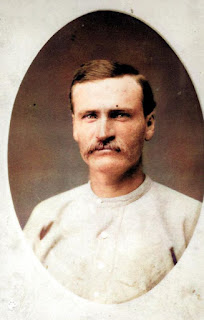Not until I became a keen family historian did two well-hidden secrets eventually come to light. Today these matters would not be kept secret and would not really matter, but there was a time when this was something that would have caused embarrassment and discrimination.
The secrets related to the fathers of my two grandmothers. Having been born half a world apart in quite different cultures, the two illegitimate births were treated differently even at the time.
 |
| Carl Johan Nelson |
1. Carl Johan Nelson (1839-1911), my paternal grandmother's father, was born in Ringerike, Buskerud, Norway on 26 August 1839. The Lutheran State Church was responsible for maintaining the official vital records for the country. Hence, the following entry (highlighted in yellow) is the official birth and baptism certificate for Carl Johan. Although babies in Norway were usually baptized shortly after birth, Carl was about 10 months old.
 |
| Birth and Baptism Record for Carl in the Norderhov, Buskerud Church Book |
No secrets buried here! The column to the right of the child's name indicates whether the child was born in or out of wedlock: Carl was born out of wedlock. Whenever possible, fathers of illegitimate children were named as was the case for Carl. From this, we see that his parents were Nils Olsen Sorgefoss and Guri Larsdatter.
The plot thickens when Carl's baptism record reveals that both parents had had previous children born out of wedlock (far right column). It seems rather cruel to have plastered this onto the record for innocent baby Carl! Nils had fathered a son Martin Nelson with Berthe Halvorsdatter early in 1838. Guri had a son Engebret Nelson fathered by Nels Erikson Honnefoss in 1833. Nils would eventually marry the mother of his son Martin in 1842; Guri never married and raised her sons on her own.
It must have made for interesting times for the 3 boys in the small community and might explain why Guri's sons chose to move to America when they grew up. More details can be found in another story on this blog.
********************
 |
| Charles Francis Edwards |
2. Charles Francis Edwards (1869-1941), my maternal grandmother's father, was born three decades later and an ocean away in Keokuk, Iowa on 22 February 1869. As far as I am aware, his secret died with him after he seems to have successfully masked his illegitimacy by inventing a history of half-truths and outright lies.
The story he told was that he was orphaned at a young age and raised by an older sister Grace. His mother, he said, was Rachel Hoover, a cousin of President Herbert Hoover. She had been married three times - first to another Hoover by whom she had a son Sam, next to an Edwards by whom she had twin daughters Minnie and Grace and him and then finally to a Payton. His family were devout Quakers. I wasted untold hours trying to find records of his family in Quaker records. The were NOT Quakers. I wasted untold other hours tracing the ancestors of President Herbert Hoover to try to find any connection to my Hoovers and Edwards. They were NOT related to President Hoover that I could ever discover.
One piece of information I had located in the marriage record for Charles when he married Mary Jane Edwards in 1896 was that his parents were Louis Edwards and Martha (not Rachel) Hoover. But I could never find Louis and Martha in any other records.
Eventually I was assisted by genealogist Alice Hoyt Veen of Iowa who was able to determine that Charles's mother was actually Barbara (not Rachel or Martha) Hoover. She found parents and extended family for Barbara and was able to establish that Charles had at least told the truth about his mother having been married three times and the children she had.
But Charles was NOT orphaned at a young age. He was a young man living with his mother and working in Independence, Kansas when she died there in 1890.
It also became clear that Barbara's second husband Louis Edwards died shortly after the end of the Civil War in early 1866 and could therefor not have fathered Charles three years later.
Sadly, American vital records in 1869 in Iowa were non-existent. Not only is there no record of who fathered Charles, there is NO birth record for Charles and hence no paper trail.
Until genetic genealogy became available it seemed we would never know who Charles's father was. Using DNA and spending untold hours analyzing results for various family members who were tested eventually led me to a family named Saum where one of three brothers was almost definitely his father. A more complete story of my search can be found through another story on this blog.
******************************
Both my grandmothers had fathers with secrets surrounding their births. In one case it was an open secret fully acknowledged in public records while in the other is was completely buried. There is no evidence that either of my grandmothers ever learned their fathers' secrets.






